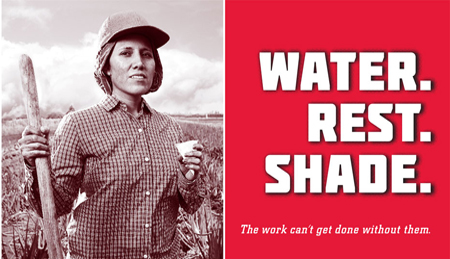The Occupational Safety and Health Administration (OSHA) announced a final rule Sept. 11, 2014, revising the requirements for reporting work-related fatality, injury and illness information. The rule also updates the list of employers partially exempt from OSHA record-keeping requirements.
Tags: Pinnacle Employee Services, OSHA, Injury Reporting, PES
Listen up employers. Over the past month the heat wave has been sweeping the nation. With temperatures reaching into the triple digits. Employers need to educate their supervisors, managers and outside workers of the dangers that are associated with Heat Illness. OSHA and Cal/OSHA have started a campaign called, “Water. Rest. Shade”. This campaign provides employers with education resources for employers and workers. OSHA and Cal/OSHA have provided a Heat Illness Prevention Kit for employers to help educate and prevent heat illness in the workplace. This information is in Spanish and English. OSHA has gone as far as creating an app for Heat Safety. The app is available for Android, iPhone and coming soon to Blackberry.
Tags: OSHA, heat illness prevention standard, outdoor employers, outdoor workers, HR Allen Consulting Services, HR Informant, Cal/OSHA, heat illness, heat illness prevention
Cal/OSHA recently launched a statewide Confined Space Special Emphasis Initiative to focus attention on the hazards posed by confined spaces in worksites. Cal/OSHA also issued a Confined Spaces Hazard Alert to assist employers with identifying confined space hazards and taking steps to prevent injuries.
The initiative was spurred by investigations of confined space deaths and injuries in California. In 2011, seven California workers were killed in confined space incidents, including two young brothers who died from toxic gases in an underground drainage system at a recycling center.
Confined spaces can include tanks, silos, pipelines, sewers, storage bins, drain tunnels and vaults, and can be found in many industrial worksites and also in non-industrial settings, such as health care, education and retail.
Tags: OSHA, Confined Spaces, Hazards, Cal/OSHA
Tags: workplace safety, OSHA, Agency Rulemaking, Whistleblower, Sarbanes-Oxley, Dodd-Frank, Uncategorized
Generally, the SST defines key terms, describes the three inspection lists, provides scheduling and inspection procedures, and gives information on OSHA coding. In addition, the report includes three appendices that provide information on the industry groups included in the 2010 ODI, includes a checklist for compliance safety and health officers (CSHOs), and instructs Area Offices on how to use the Inspection Targeting website. The targeted employers are culled from various manufacturing, non-manufacturing, and nursing and personal care facilities.
As was the case under last years SST, if a CSHO?discovers that an establishment slated for inspection is a Voluntary Protection Programs (VPP) site, he or she must exit the site without conducting an inspection, and the establishment must be deleted from the inspection list. Similarly, if the establishment takes part in OSHAs Consultation Safety and Health Achievement Recognition Program (SHARP), then the inspection officer must leave the site without conducting an inspection. If the establishments application to either of these programs is pending, then the inspection will be deferred.
In addition to the SST program, OSHA operates a number of national and local emphasis inspection programs aimed at specific high-risk hazards and industries.
In a press release, OSHAs Assistant Secretary of Labor David Michaels said: By focusing our inspection resources on employers in high hazard industries who endanger their employees, we can prevent injuries and illnesses and save lives, adding: Through the SST program we examine all major aspects of these operations to determine the effectiveness of their safety and health efforts.
by Ilyse Schuman
Tags: Agency Happenings, workplace safety, OSHA, High-Hazard, SST, Site-Specific Targeting, Uncategorized


















